News Archive
Weekly Balloon News #11 - Chinese Balloon Edition - March 4th. 2023
My passion for scientific ballooning led me to create and maintain this website called StratoCat for almost 20 years, which has become a reliable and independent source -at least I believe so- of information on the subject, with no affiliation or support from any company or governmental entity in the sector, and to which I dedicate all the free time that my work and family allow me.
However, since the appearance on NORAD radars and the public opinion of the now famous Chinese balloon, my daily routine has taken a tremendous turn. I found myself overnight being pointed out by several people on the internet as an "expert" on balloons, solely for being responsible for one of the few existing references on the subject on the internet. Far from that classification, I could rather consider myself an admirer of that technology and its possibilities. Overnight, I started to be contacted by the press, TV channels, and digital media from various places, asking me about the mysterious Chinese spy balloon program, what I thought the capabilities of the famous balloon were, or even better, its intentions. Far from being able to satisfy all those questions, I limited to providing the little knowledge I had on the subject and some more or less well-founded opinions.
Thus, with all the attention focused on the whirlwind of events that have taken place in recent weeks, it was only today that I was able to sit in front of the computer with enough time to write something for my own newsletter. Initially, this report would be a complete timeline of the event, then it evolved into a structure similar to a FAQ (Frequently Asked Questions), and finally, it ended up in this brief summary that you are about to read. In the interest of brevity, I will not reproduce the complete plot of the event (covered in various ways by the press and magnificently summarized by Wikipedia in a well-documented entry) but I will limit this write up to exploring the points that, in my opinion, are the most interesting of this whole matter.
Let's begin.
What kind of balloon it was?
Before looking at the case of the Chinese balloon, let's take a look at the types of stratospheric balloons that exist. Without going into too much detail that is beyond the scope of this brief article, we can divide all stratospheric balloons into two main groups: open and closed. Or technically known as zero pressure or super-pressure. Let's forget about propulsion systems, materials, or sizes for now.
Zero pressure balloons ("open balloons"), are the style that when inflated with a gas lighter than air (such as helium or hydrogen) will ascend until the expanding volume of the gas becomes equal to the constructed volume of the balloon. After which the excess gas is vented out via ducts on the bottom, establishing the "float" altitude. The balloon will stay at the float altitude until the cooling environment in the afternoon reduces the gas temperature, thus shrinking the gas volume and losing buoyancy. Due to the heating of the gas by the sun, or the cooling of the gas at night, the balloon will experience variations in altitude, which can be compensated for by venting gas in the former case, and by ejecting ballast in the latter case. For obvious reasons, the cycle repeats every day/night until the balloon loses enough gas to no longer be able to fly, or runs out of ballast to compensate for nighttime contraction. That is why only under very special and exceptional conditions can a zero-pressure balloon perform a long-duration flight.
Super pressure balloons ascend just like zero pressure balloons do, but when the gas volume expands to the constructed volume, the gas is not vented. Instead, the excess gas is usefully employed to pressurize the structure thus maintaining a constant volume. That in turn displaces a constant volume of ambient air which is the source of its buoyancy and maintains a constant altitude. When the environment changes to either make the gas hotter or colder, the volume stays the same but the internal pressure (which is greater than the ambient pressure) ranges up and down instead. Such a vehicle has to be very carefully designed since it is acting like a pressure vessel. This is possible thanks to a series of "reinforcements" that allow the balloon to resist the tendency of the gas to expand due to heating without causing it to burst.
As there are no changes in the mass or volume of the balloon, it will remain at a more or less constant flight level.
This is, in a very abbreviated way, the main characteristic of the two types of stratospheric balloons. Clearly, the balloon in question was of the second type.
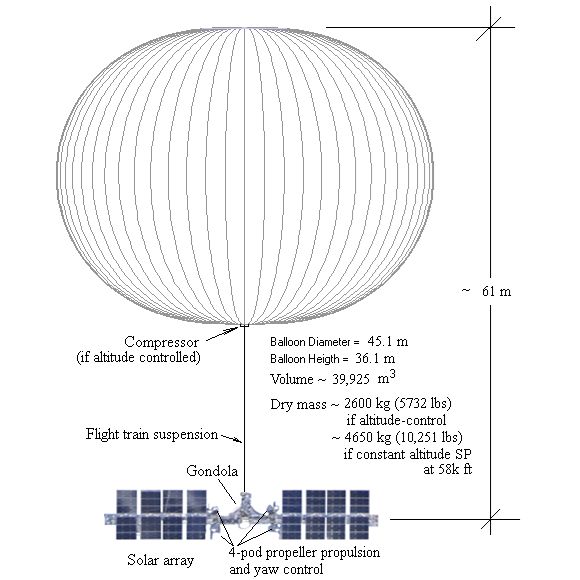
My main source of information on this particular point has been Engineer Rodger Farley. From the beginning of the event, Farley began to make his own analysis and estimation of the type of balloon involved based on the evidence that was appearing, which he circulated among his acquaintances. Farley was a NASA engineer for 35 years and I invite you to learn about his work on the website of the firm of which he is the head Farley Flight Aerospace LLC and Teacup Navigation, which provides advice on all aspects related to stratospheric balloons. Suffice it to say that he was involved in the development of the NASA Super Pressure Balloon (when it was still called the Ultra Long Duration Balloon or ULDB) and was part of the team that developed the Variable Altitude Air Ballast Balloon System or VAABBS, better known by its commercial name of Stratolite, currently the flagship vehicle of the World View Company of Tucson, Arizona.
With such experience behind him, as soon as the case gained public notoriety, Farley began to analyze the type of vehicle we were dealing with based on the images and the little reliable information available. In the last version of his analysis (the twelfth) that he circulated just a few days ago, he included the diagram next to these lines in which the estimated dimensions of the balloon are summarized, and from there the estimated volume and weight of the transported cargo.
Initially the only size reference came from one of the official sources that mentioned "the length of three buses" during the first day of the event. However, it would be necessary to wait several days after the shoot down to have a slightly more exact approximation. First of all, on February 17, the Synthetaic company announced in an interview with Space News that using AI (artificial intelligence) applied to satellite images provided by Planet Labs, it had been able to reconstruct the previous trajectory of the balloon, being able to locate it at 4 different points, two over South Carolina, Missouri and over Canada. In that same interview, the CEO of the company stated that "We were able to take measurements from the pixels and validate it was about 148 feet in diameter and flying at 58,000 feet."
The second confirmation would come from the famous photo (see below) taken on February 3 from the cockpit of an U2 spy plane over Missouri. According to their official facebook page, the plane was dispatched from Beale AFB in California. Farley comments in his analysis that his colleague John Morehead of Gossamer Aerospace calculated the max diameter to be 140 ft by using the U2 shadow on the balloon surface as a length reference.
Another intriguing question regarding the Chinese balloon is its shape and composition. To be honest, the depth of Farley's analysis on this point is well beyond my basic comprehension of the subject as it involves an advanced understanding of the internal structure of super pressure balloons, formulas for calculating their surface area and distribution of internal and external forces, etc. As a summary, after years of experience and dozens of failed designs, it has been shown that one of the shapes that best "resists" the internal pressure in a super pressure balloon of that size, is the so-called "pumpkin" shape with meridional tendons. In this sense, the Chinese balloon does not seem to fit exactly that geometry. It appears to have almost 90 gores and some kind of meridional reinforcements, but not as bulged lobed as in the pumpkin design. It could be classified as an hybrid in which the height/diameter ratio is different from that of the pumpkin balloon. Hence it has a more spheroidal shape due to the inclusion of hoop stress in the gore fabric. According to Farley’s analysis this may be to make the shape more aerodynamic and dynamically stable when moving with propulsion.
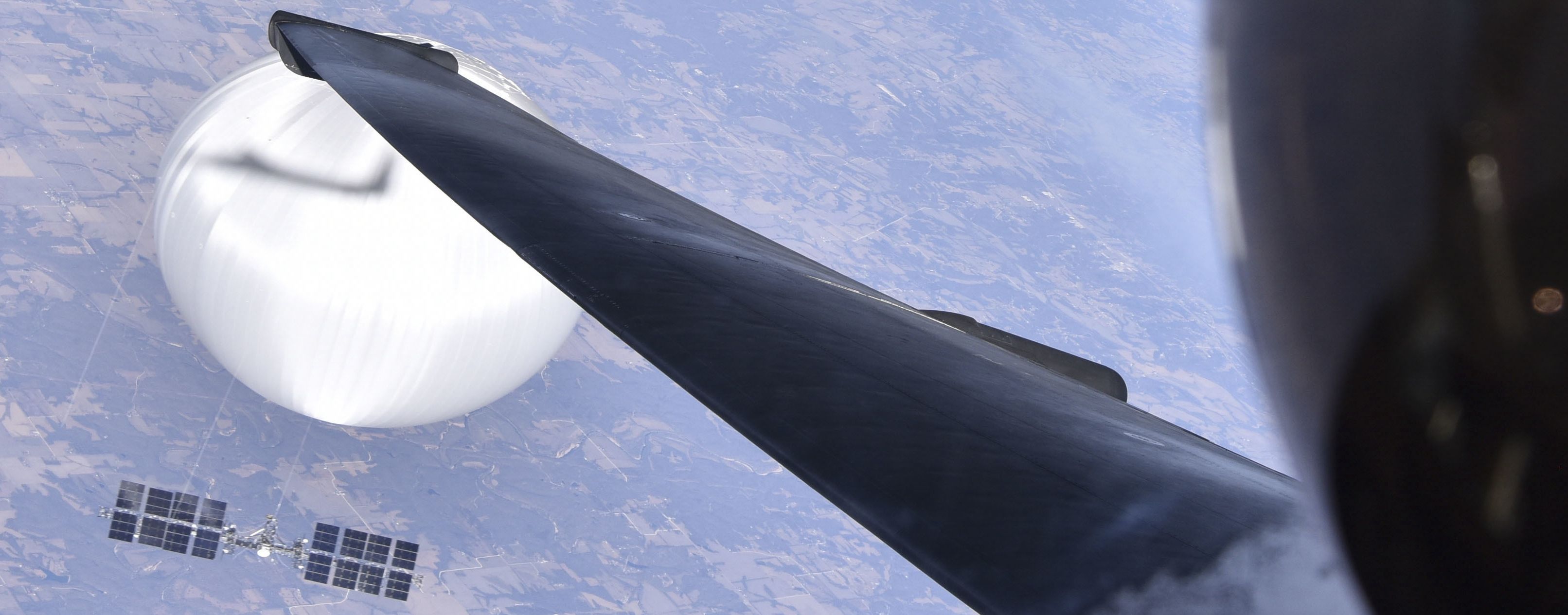
As said at the beginning, the balloon is clearly a closed superpressure balloon that flies at a constant height. Some official sources suggested that it possessed some sort of maneuverability, which raises a number of questions. On one hand, there is the possibility that the balloon used an altitude control system similar to the one which was used by the balloons of the ill-fated Project Loon, or by the Thunderhead balloons currently operated by Aerostar. Briefly, that system consists of a closed superpressure balloon, inside which is located a smaller balloon known as a "ballonet" that serves as ballast and is the heart of the steering system: air is introduced into it by means of a compressor that allows the balloon to modify it’s weight to go up or down following prevailing currents. Although it is not possible to directly control the course or the speed, these changes in altitude allows the balloon to take advantage of the different wind patterns at different altitudes to navigate and thus remain "orbiting" over a place of particular interest. However, as soon as we analyze the route followed by the balloon from its appearance in Montana to its final destination off the coast of South Carolina, it becomes clear that it was not the case. According to many meteorologists who analyzed the route the balloon followed, using their day-to-day computational models, the balloon seemed to follow the forecasted wind pattern for the altitude it hovered, ruling out the presence of any system that could notably alter its route.
Notwithstanding this, the now very famous photo taken by the U2 plane which provided a detailed view of the balloon, showed also some interesting details of the payload itself including the presence, albeit somewhat diffuse, of what appear to be four propulsion propellers. In this sense, Farley cites a study he did at NASA in 2013 for a constant altitude super pressure pumpkin balloon with a gondola having twin propeller propulsion. For a balloon designed to fly at 65,000 feet, a system based on two propellers of 2.5 meters of diameter could drag the balloon 1-2 m/s which in his opinion is not enough to go against the winds at that altitude, but enough to influence the trajectory by "bending" the path. He concludes that perhaps the Chinese balloon was not an altitude control type, but one with a little propulsion to bend its trajectory.
Other expert I've contacted gave me another possible explanation for the presence of the propellers besides propulsion. What if these were not used to change the balloon trajectory, but to rotate the truss to orient the solar panels to point to the sun for maximum power generation?. The propellers could also be used to alter the balloon trajectory either at the same time or during the night time if they had enough battery storage. However, in that case it must be taken into account that the weight of battery storage could be a limiting factor.
Regarding the payload and its purpose, it is something that the FBI, the body in charge of analyzing the remains recovered from the ocean floor, may answer in the near future, or else keep it secret in the interests of "national security". What is ruled out is the merely civil and scientific character of such a large deployment. Assuming the size of the balloon between 140 and 148 feet in diameter, the horizontal truss on which all the elements that make up the payload are mounted would have a length of 111 feet. The central part is occupied by a vertical structure that seems to have a kind of high-gain antenna at its base, probably for data transmission via satellite. From the upper part of said structure you can see a series of cables that connect to the ends of the truss, perhaps to give it greater integrity. As for the solar panels, a quick measurement yields a surface area of 102 square meters (16 panels of 2.7 x 2.3 meters each) which allows calculating a generation capacity of between 23.5 and 32 kW depending on altitude. That's a lot of power to simply power four electric motors and a suite of scientific experiments, complex as they were. Some experts consulted suggest that among these elements could be found from electronic signals intercepting devices up to a synthetic aperture radar. But so far this is just speculation.

Finally, one comment I heard repeatedly from the various experts I spoke to in the days following the event was how difficult it must have been to launch that type of payload. The arrangement of the solar panels and the probable weight of the assembly would make the maneuver a nightmare for any flight director. Another enigma related to this point is that of the appendages that hang from the globe. In the photos taken by Frank Melliere over Modoc, Illinois on February 3, a fine vertical line could be seen, which seemed to be made of the same material as the balloon's envelope. Now, in the photos taken by the U2 that same day, two of these appendages can be seen. What initially appeared to be one of the inflation tubes (which once completed are tied at one end to prevent the escape of gas) could now well indicate, in Farley's opinion, that it could be a kind of mooring rope that could be used to hold the balloon in position during the release. Other experts, such as Dan Bowen, associated this appendage with a similar one used by the technicians of the Loon Project to have better management of the apex of the balloons during inflation. In that place is where a small ring of very light metal was located that served as a mount for the helium vent valve, something that is common to almost all models of stratospheric balloons.
Not an isolated incident, and not a “fleet” of spy balloons.
Something we should all agree on is that there has been a lot of exaggeration on both sides, in some cases even bordering on hysteria. On one hand, China argues that it was only a balloon, or as they prefer to call it, a civilian airship, for observing the weather "that went off course". Since when do you observe the weather by flying from one end of the continental territory of your main commercial, political, and military rival to the other? A weather balloon carrying solar panels capable of generating 25kw of power to feed a radiosonde and a hygrometer? On the other hand, it was not just an isolated incident.
While we watched incredulously the spectacle provided by the Chinese balloon over the northwestern of the US, my friend Gonzalo Blasco with whom I share the hobby of chasing balloons around the (virtual) world for some years now, warned me that a similar spectacle was happening over Costa Rica, several thousands miles south. Immediately, I began searching social media for more references and indeed found some blurry photos of a whitish object crossing the isthmus from west to east but without much definition. At first, I was skeptical, since the only press publication used a 2020 photo of a similar balloon that appeared over the skies of Japan as its cover image. However, all my doubts would be shattered when I saw the impressive images obtained by David Naranjo, Jose Mora Mora, William Solis, and the L10n Astronomy Group, which I reproduce below.

Undoubtedly it was an object with similar characteristics to the one that kept the pentagon in suspense. A balloon off course. It could be. But two?. Regarding this second balloon, China remained silent and has not issued any statement. Blown by the winds, the balloon would continue its journey to the east and would be sighted in subsequent days over northern Colombia -where it motivated a statement from the Air Force of that country- and over Venezuela, before being lost into oblivion.
A particular detail of the second balloon is that it seemed to have some problem in the alignment mechanism of its solar panels, and one of them is not aligned with the rest. As we have seen in Farley's analysis, of the different images taken at different times of the day over the US, the solar panels appeared to have some kind of mechanism that oriented them towards the sun. If we look closely at the different images of balloon No. 2 we can see that one of the panels seems "stuck" and does not align with the rest. This characteristic is repeated in all the images that allow discerning with some definition the payload below.
Parallel to these two incidents, Canada had announced in an official statement that it was tracking another possible balloon over its territory, although the statement simply referred to the issue in “potential” terms. Finally, the lack of sightings or images of that third balloon over Canada, suggests that perhaps they were referring to the "objects" that in later days would be tracked down and shot down in Alaska, the Yukon and Lake Huron which according to the available evidence could be small harmless balloons launched by hobbyists.
The overreaction that led to such paranoia in the days following the shot down of the Chinese balloon seems to have calmed down, fortunately for the entire scientific and educational community that greatly benefits from the information obtained by these balloons and their potential to stimulate STEM careers for young students.
Previous sightings. Connecting the dots
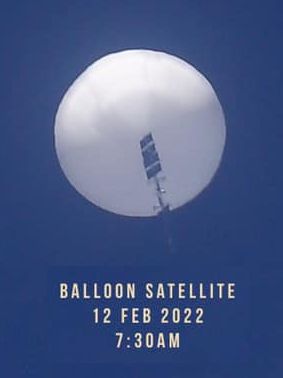
The incident of the Chinese balloon, that caught the eyes of the entire world, brought to the fore and gave a possible explanation to a whole series of events dating back to 2019 that would otherwise have been forgotten. It came to partly solve an enigma that intrigued many balloon fans -among whom I was- since middle 2020. In June of that year, the Japanese city of Sendai witnessed the passage of a strange balloon which was registered on video on local TV and by several witnesses from the ground. At that time, it was not possible to establish for sure how high it was traveling, although some testimonies spoke of about 40,000 feet or more. What was evident from the video testimonies was that the balloon carried a "structure" underneath in which one could clearly see a couple of propellers working under the device.
I always believed that this event would be explained years later as part of a then undisclosed initiative of some Asian "startup" that was testing an innovative aerial platform, as occured with project Loon balloons before they came to the public eye in June 2013.
In September 3, 2021 a similar balloon was caught by Masahiro Iwamura a photographer taking nature shots in Aomori prefecture. That same month, on the 26th but over Taipei, the capital city of Taiwan, hundreds of witness contemplated another balloon passing by the city.
Japan and Taiwan were not the only nations whose airspace was flagrantly violated without warning by an "off course" balloon. In the year 2022 several of these reports began to populate social networks in various parts of Asia and the Pacific. In January 6th, the city of Port Blair, in the Andaman and Nicobar Islands belonging to India saw a similar balloon in the sky that triggered curiosity and UFO rumours among the population. In February 12th, a similar incident (pictured at right) occured over Candelaria, Phillipines, but it was not widely spread. Probably that same balloon would move east and appeared north of Hawaii triggering a never fully confirmed “scramble” to try to intercept it. This event led to some confusion due to the fact that west of Hawaii two Thunderhead balloons belonging to Aerostar, a US balloon firm, performing some tests and clearly visible in plane tracking apps, while the intruding balloon didn't carried a transponder on.
Another event related to a possible Chinese intrusion into Philippine airspace, but with a different vehicle than the one we are discussing, occurred on December 18, 2022 the inhabitants of a large part of the Province of Pangasinan, in the Philippines, were shocked by the presence of a bright object in the sky. Detailed images obtained by several witnesses showed the presence of a stratospheric airship, very similar to the ones being developed by China during the past decade. I covered the whole event in a previous issue of this newsletter.
The first downing using missiles? Yes and No
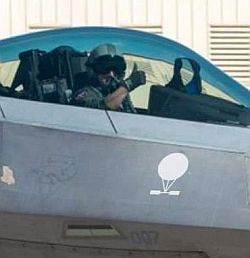
The Chinese balloon was shot down off the coast of South Carolina, by an AIM-9X Sidewinder missile fired from an USAF F-22 Raptor. The plane that was dispatched from Langley Air Force Base in now show on its side the unusual kill mark. Althought, the shoot down is mentioned as the first air-to-air kill of a stratospheric balloon using a missile, it is correct, but not completely.
60 years ago, a scientific balloon launched from the US would be the first "victim" of an air-to-air missile. A huge double balloon system (known as tandem system) was launched on December 12, 1962 from Palestine, Texas, on the grounds of the future NASA balloon base, then operated by the National Center for Atmospheric Research. The objective of the flight was to make a launch test of a "dummy" version of a gargantuan balloon-borne telescope called Stratoscope II, one of the most sophisticated balloon-borne telescope systems ever flown.
Stratoscope goal was to photograph planets and stellar nebulae from Earth's stratosphere with previously unseen precision in an effort that can be viewed in perspective as a distant precursor to the Hubble Space Telescope. The project was under the direction of Princeton University, and was sponsored by the National Science Foundation (NSF), the Office of Naval Research (ONR) and counted with additional support from the National Aeronautics and Space Administration (NASA).
As mentioned, this flight was meant to be the first full-scale test flight, for the Stratoscope II project using a mockup of the real telescope that simulated the mass, size and weight of the real thing. After being released at 17:25 CST, the balloon made a nominal ascent to float altitude and performed flawlessly during the entire night. At dawn, a signal was sent to valve the apparatus down, but the balloon didn't respond. An automatic timer triggered the exhaust valve, and the balloon came to earth near Krotz Springs, Louisiana, but the ballast container spilled accidentally and the balloon rose again, but only to 14,000 feet, since much of its gas had been valved off.
As a result, the balloon drifted across the Gulf of Mexico and Florida, then out over the Atlantic. When approaching heavily traveled air lanes, it became a navigational hazard and thus two Navy F4B phantom interceptors were sent from Boca Chica Naval Air Station which fired Sparrow missiles to take it down, about 100 miles off the coast.
The "secret" Chinese balloon base
In the midst of the news turmoil during the Chinese balloon event, the press was competing with each other to see who would find out which secret first. So each new element that appeared on the scene was often magnified by the lack of context or knowledge. Since I started this historical compilation project about stratospheric balloons around the world in 2005, I ran into difficulties to obtain information about this or that program. The Chinese program is just one of those cases, a bit because of the language barrier, and a bit because of the closed character of the Chinese regime. However, over the years, navigating websites of unknown institutes lost in the bureaucratic tangle of the Chinese state, some clues and information started to appear.
During the first days of the Chinese balloon event I was interviewed for an article in the Wall Street Journal. When the article in question was posted online, the headline of the piece was a photo of an alleged secret Chinese facility published exclusively by the newspaper. The truth is that I had never seen that installation before. I immediately contacted the person who had interviewed me to see if he could give me the approximate coordinates so I could locate it on some satellite image site. In a very polite way, he explained to me that he couldn't do that and suggested that I contact Planet Labs directly.
Knowing in advance that it would be difficult to get a positive answer, I decided to try to find it myself, with the only reference being that it was located in a desert area in the Inner Mongolia Province of China and had an octhogonal shape with radial appendages. Twelve hours and a terrible backache later, I was finally able to find the damn facility. I've posted it on Twitter and the reaction was impressive as you can see, by the number of comments and likes and so on. Below these lines we can see the images.
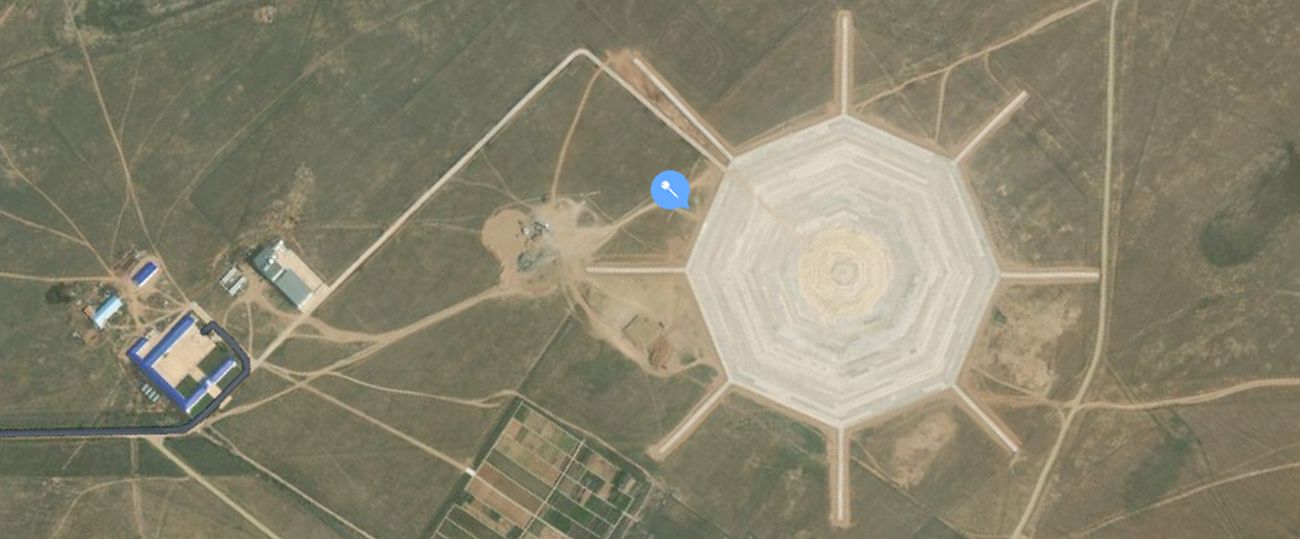
The facility is located in an isolated outpost in the Siziwang Banner, 138 km north of the city of Hohhot, and curiously less than 3 miles east from one of the most important tourist attractions in this desolate area: the Gegentala Grasslands National Park. For those who want to see the images on their own, the coordinates are: 41°46'52.21"N and 111°54'0.43"E. From experience I suggest using Apple maps that shows the most up-to-date images. To be able to do it for free, you can use the DuckDuckGo search engine.
I was very proud of myself for being able to locate on my own some additional clues about the elusive Chinese balloon program. However, althought I've never mentioned it explicity, in those frantic days many people wrongly assumed that I've found the secret place from where the nasty "spy" balloons were being launched by dozens. The naked truth is that after making some research, the base seems far from being a "secret" facility. I've refined some searching skills over the years and after a few more hours of backache, using some chinese search engines I've located several news in the media about the base.
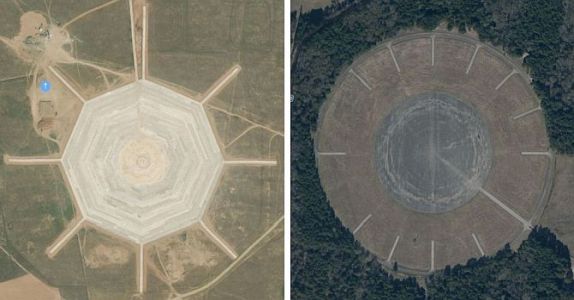
Here is for example an explanation of the project behind it including a fancy drawing showing future capabilities. In other page we can find information on some airship tests performed back in 2011 (with a picture showing the main building still with the roof painted red) or more recently in 2020 a visit of what appears to be a bunch of students into the installation, showing from the side the radome building and the happy group making balloon launches in the concrete pad.
As we see in the image above, what appears to be the launch pad of the Chinese facility (left) closely resembles the circular platform located at the Columbia Scientific Balloon Facility in Palestine, Texas (right). The radial appendages that cross both structures are called "fingers" in the jargon and allow choosing the direction in which the balloon will be deployed during inflation, depending on the direction of the surface winds.
The resemblance of both facilities is not only functional, but I would dare to say that it even entails a metaphor: in several recent publications, the repeated mentions and comparisons, allow us to glimpse that the NASA balloon program is where China's balloon program, at least in its scientific facet, finds an aspirational goal. At times as a role model, at other times as the rival to beat.
Science on the edge of reality
To the rampant hysteria caused by the event on part of the public who contemplated with awe the passage of the balloon without anyone willing or able to stop it, would be added -of course- innumerable conspiracy theories that populated forums and comment sections in the mass half. Also, the confusing statement by General VanHerck, head of North American Aerospace Defense Command when he said that he had “not ruled anything out” in determining the nature and origin of the objects, opened the door to the only element that was missing in this already confusing conversation: aliens. Others pointed to the event as a "cover" for other more serious issues that were happening in the US at the same time (the derailment of East Palestine in Ohio for example) and that the press seemed to "ignore" submerged in Chinese balloon fever.

However, of all the stories I heard in those days, one of the ones that caught my attention the most was the one that warned that the balloon in question could carry an artifact to emit an Electro Magnetic Pulse (EMP) and disable all the defensive capacity of the US Government. The craziest thing of all was that they cited a page on this website as a “source” for that claim. The page in question refers to YUCCA, the code name of the first and unique test of a nuclear device carried by a stratospheric balloon. The main goal of the test, sponsored by the US Department of Defense and Los Alamos Scientific Laboratory was to study the effects of the detonation of a "W-25" air defense warhead at high altitude based on the possibility of using nuclear detonations in a defensive role against aircraft and ballistic missile attack. This test, was performed in the Enewetak Atoll in 1958, as part of Operation Hardtack I.
The fact that an EMP is produced by a nuclear explosion was known since the very first days of nuclear weapons testing, but the magnitude of the EMP and the significance of its effects were not realized for some time. According to the data published in the final report of HARDTACK which was declassified several years later, YUCCA provided the first indication that high-altitude EMP could be more than 1000 times as intense as low-altitude EMP.
To help dismiss some of the theories that mentioned the possibility of the Chinese balloon carrying such a device I've spent a few hours updating the flight report regarding the test to show what it meant to transport a nuclear weapon in a balloon and the complexity and security measures associated with it inside the controlled space of a nuclear test site, let alone what is involved managing the deployment of such a device in a free-floating balloon across the globe. It is such nonsense.
The "weather balloon" explanation 70 years later
In a political recreation of the now famous viral meme of the two spider-men pointing at each other, the two powers involved in the crisis assume their role on the stage of world public opinion: China on its side crying to the four winds that it was just a "civilian weather balloon" that went off course, very offended by the affront of the shoot down and demanding the restitution of the remains. The US on the other hand, demanded explanations, making a strong (albeit belated) demonstration that it will not allow more invasions into its airspace, and showing a rather nervous pulse on the trigger, not only shooting down the supposed spy balloon but erasing from the map an innocent balloon from an Illinois hobby club.
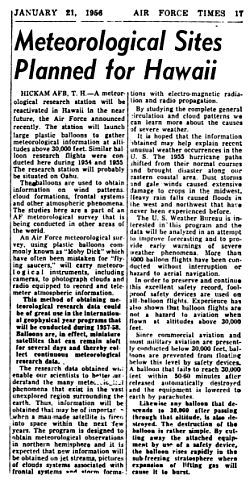
To be honest, I believe that US is right on their demands. But in the same sense of honesty, we must not forget that a few decades ago, this same world powers (plus the USSR) were in exactly the opposite roles.
GENETRIX, also known as Project 119L and by other code names that reflected different phases of the program like "Gopher", "Grandson" and "Grayback" was a secret program started in 1950 and executed in 1956 by the United States Strategic Air Command (SAC) and other agencies, with the objective of obtaining photographic reconnaissance of the Soviet Union using high resolution cameras transported by stratospheric balloons. Two other balloon programs started a few weeks before GENETRIX: under the code name of White Cloud and Moby Dick Far East dozens of balloons were launched from sites in Japan and Hawaii and widely reported in the world press as a cloud study. The publicity stunt was believed that would serve as a cover in case -as occurred- that some camera-carrying spying balloons would end in Soviet or Chinese hands.
I will not go into extensive details that are not pertinent to this report, but I will give you this link that will guide you where to find here at StratoCat all the available information, including technical details and the complete record of balloons launched by the program.
We must remember that what I’ve mentioned above occurred in mid 50’s during rising tensions between East and West. With satellites still ahead in the future and the U2 spy plane barely rising from the drawing boards of Kelly Johnson's Skunk Works, the desperate search for information of that "black box" behind the Iron Curtain, and specially the need of reliable information on strategic capabilities of the potential enemy, gave birth to one of the most complex programs of the early cold war. Nowadays, things are very different. Most powerful nations in the world count with satellites to spy each other whitout the need of risking man power nor expose their actions to public ridicule.
Of the original plan for GENETRIX that contemplated to send 2500 balloons, merely 516 were launched on the 27 days that endured the effort. Angry protest from the Soviets and the low number of payloads recovered, led to the termination of the program in early February of 1956. The soviet protest included -as usual- a great propaganda move which took place in the evening of February 9 with the exhibition on the Spiridonvka Palace in Moscow of dozens of Genetrix payloads, balloons envelopes, cameras, ballast boxes and exposed pictures. Same did their Chinese colleagues with several downed payloads which were exhibited to the public.
As occured 70 years ago, we have already had the usual protests in this type of international crisis. Now we must wait if we will ever see a similar spectacle on the part of the FBI with the recovered remains of the Chinese balloon.
Conclusion.
After this somewhat eclectic road across the Chinese balloon event, its time for some conclusions. I will do my best to offer my point of view as objectively as I can.
- Clearly, as we saw when analyzing the characteristics of the balloon that caused the entire incident, IT IS NOT A MERELY SCIENTIFIC DEVICE. Rather, its advanced design and capabilities could be used for strategic electronic surveillance tasks in remote areas of particular interest for China.
- I don't think China intentionally sought to introduce to the world's eyes a technology that until now it had used in a much more discreet way in its backyard in Southeast Asia. At this point, I do believe that somehow they "lost" the ability to control the balloon and it ended up making the grand tour from Chinese lands to the bottom of the sea in Myrtle beach. In my humble opinion China was not looking for the humiliation of the shootdown even though now, of course, they try to take advantage of the situation as a "victim". I think that if they really had the ability to stop the balloon before entering North American territory in such a flagrant way, they would have done it.
- As mentioned before, the route followed by the balloon matched the forecasts at the height it was moving, and showed no signs of modifying its route to approach places of particular strategic interest. It is true that the proximity of the balloon to certain sensitive places such as underground missile silos and military bases did not contribute to ease the generalized hysteria, but let's be honest: is there a chance to cross US airspace in a random course without passing sometime over what could be considered a sensitive area of any kind?
- Although the US military reaction might seem late, allowing a balloon classified as "spy" to travel practically all over its territory, it is not every day that one has the opportunity to have such a close approach to a new technology coming from a rival nation. And they clearly took advantage of that: during practically the entire journey the balloon was closely followed by specialized electronic intelligence aircraft. In this sense, we could speak of a virtual "tie" where the border between who spies and who is spied on is blurred.
- For the US and especially for its public opinion, the event was a reality check on the new vulnerabilities to which unmanned aerial means can expose even very advanced nations. This will necessarily force defense doctrines to be adapted to these new scenarios.
- The poor or uncoordinated communication with the public about what was going on and the diverse and differing opinions throughout the crisis could have spelled a disaster in terms of public relations in case the balloon had finally managed to "escape". Instead, the weather and the random path of the balloon set the perfect scenario for a Hollywood finale that served to reinvigorate a somewhat battered national pride.


